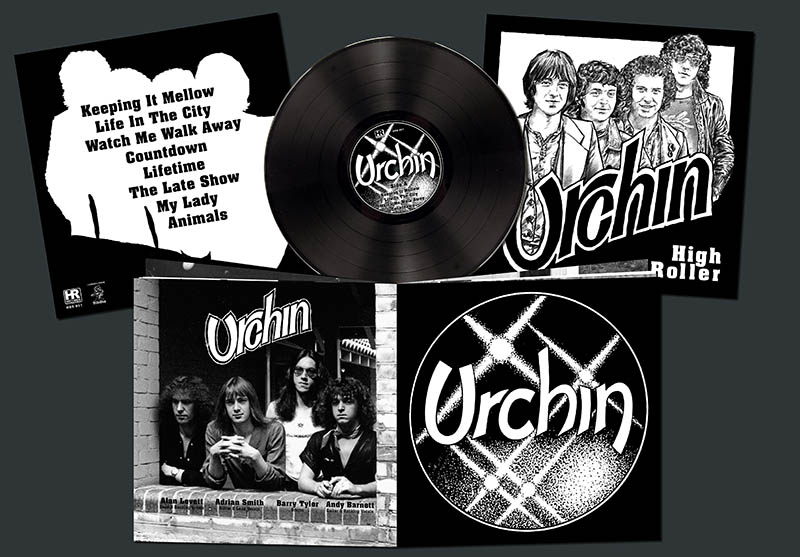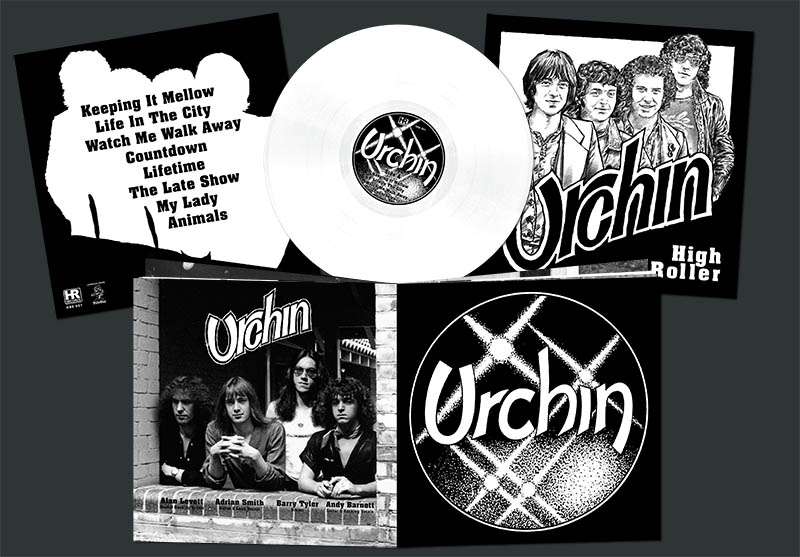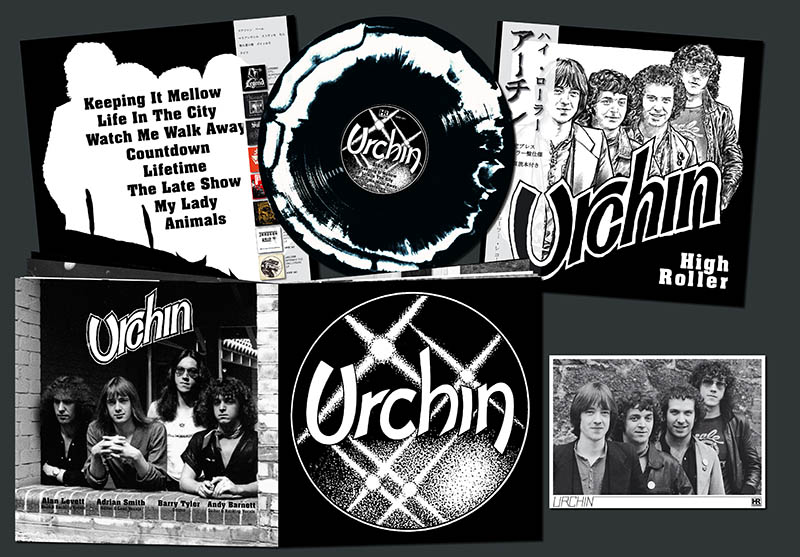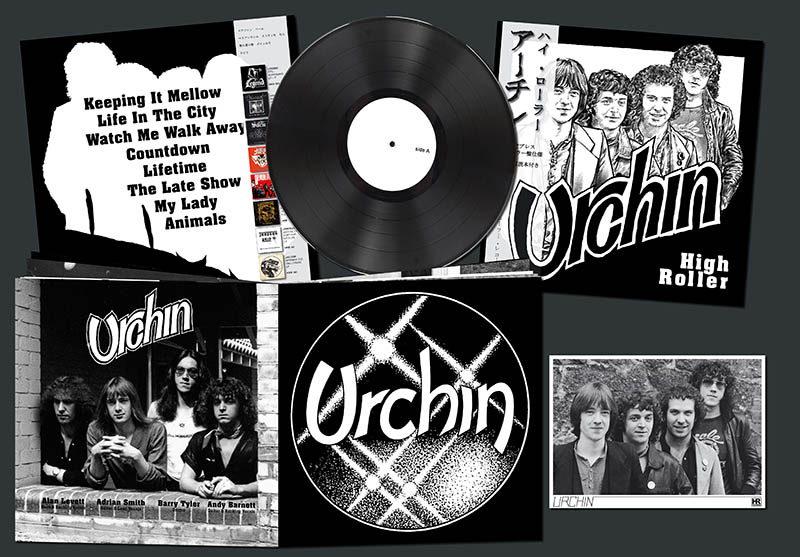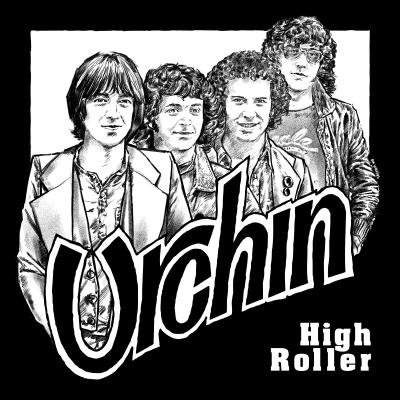 | ||||
| URCHIN - High Roller LP | |
HRR 001, 20 page booklet, 5 mm spine cover, limited to 1500 copies, 300 x white/ black blend vinyl with obi, 400 x white vinyl + 800 x black vinyl | |
| Adrian Smith - Guitar & Lead Vocals Andy Barnett - Guitar & Backing Vocals Alan Levett - Bass & Backing Vocals Barry Tyler - Drums | |
| -Keeping it mellow -Life in the city -Watch me walk away -Countdown -Lifetime -The late show -My lady -Animals | |
| SOLD OUT! | |
Graham Sclater was Urchin´s publisher and manager from 1977 until 1980. You want to know more about him? Check these sites out:
http://www.anis-online.de/2/artclub/ticket-to-ride.htm
www.flamebooks.com
“Urchin could prove to be the forerunners of a new revival of heavy British rock music.” Those lucky enough to have a copy of the first Urchin 7" single “Black Leather Fantasy” from 1977 (released on DJM Records) may know these words. They are printed on the back of the promo sleeve. And how prophetic the text turned out to be. Mind you, Urchin did not take the world by storm in the following years but they made history nevertheless! Two former Urchin members, namely guitarists Adrian Smith and Dave Murray, later joined arguably the world’s greatest Metal band: Iron Maiden. In his fantastic book “45 Revolutions” Mario Panciera mentions that a third future Iron Maiden member, namely Dennis Stratton, actually formed Urchin in late 1974 (together with his chum Dave Murray). However, this rumor still needs to be verified.
In other capacities I had compiled interviews in the past with both, Adrian Smith and Dave Murray, to talk about the band history of Urchin. This time, however, my approach has been slightly different as band manager (and book author) Graham Sclater was telling his side of the story. As mentioned earlier, Urchin was originally formed towards the end of 1974 in Hackney, East London (out of the ashes of Adrian Smiths’ and Dave Murray’s schoolband Evil Ways). This is how Graham Sclater initially came in contact with the group: “I met the band members, Adrian Smith (lead guitar/vocalist), Barry Tyler (drums), Alan Levett (bass) and Andy Barnett (lead guitar) at their rehearsal room in a basement at 144A Victoria Park Road, Hackney, East London in June 1978. I saw them play for the first time at The Swan in Hammersmith, London, a few weeks later and we agreed to work together.” By this time, Urchin had already released their debut 7" single “Black Leather Fantasy” on DJM Records. It was a brilliant piece of British Hardrock, worth every penny of the healthy three-figure asking price (in British Pounds) you would need to fork out in order to buy a copy today. “Black Leather Fantasy” and the flipside “Rock ‘n’ Roll Woman” were already hinting at the explosion of the N.W.O.B.H.M. some two years later. However, in 1977 Punk ruled the UK. So the critics were not too keen on a band like Urchin. On May 21st 1977 Monty Smith reviewed the single in the New Musical Express with the following words: “You’d think a group of youngsters would have someplace higher to aim for than pale Purple imitations.” The reviewer was probably a bit shocked that Urchin stuck to the traditions of British Hardrock and not jump on the Punk bandwaggon as was usual for 1977 ... Band manager Graham Sclater thinks that the Purple comparism was way out of order: “I played with Ritchie Blackmore in Hamburg in the sixties and he has a totally different style than either Adrian or Andy. Deep Purple had a very different style and sound. Punk had taken over and it was very difficult to get dates or any real interest in rock music at that time. Urchin were focussed on playing what they wanted to play and driven by their music and they had no intention of changing their style or direction and I applaud them for that. Time has proved them right and it was a great pity they didn’t continue.”
In 1978, Urchin released their second 7" single “She’s a Roller” for DJM, which had a slightly broader circulation but is nevertheless immensly rare nowadays. Vic Maile produced the single and the sound was much superior to “Black Leather Fantasy”. Graham Sclater agrees: “Yes, Vic Maile was a very successful producer and understood the rock genre better than most producers. Though he is no longer with us he has left rock fans with the legacy of some great music!” The critics, however, again were not too kind to Urchin. Here are two press quotes for “She’s a Roller”. Giovanni Dadomo wrote in Sounds on April 22nd 1978: “Crisp Vic Maile production on an East End quartet, proudly long-haired.” And Kim Davis wrote in the New Musical Express on April 29th of the same year: “Professional Vic Maile product but ultimately faceless music.” Graham Sclater comments: “Two very different quotes and each believed what they wrote. Remember Punk was still riding high in 1978 so their comments reflected those times.” According to Graham Sclater Dave Murray actually played on “She’s a Roller” and “Long Time no Woman” (a fact quite a few Iron Maiden historians have doubted): “Adrian formed his first band with Dave Murray when they were at school in 1972. Dave left in 1974 to join Iron Maiden and then rejoined Urchin to record ‘She’s a Roller/Long Time no Woman’. Soon after he left and rejoined Iron Maiden.” As both, Dave Murray and later on also Adrian Smith, joined the mighty Iron Maiden, Steve Harris has probably been to see Urchin live. Was this the case? Graham Sclater knows: “Yes, I booked Urchin, Iron Maiden and other bands to play together at a number of American bases in England and they regularly played together. As far as I can remember, it was late 1978 and early 1979. They regularly played together at the same venues around London.” Around this time, the star of Iron Maiden was already rising and Urchin was on the way down. Guitarist Maurice Coyne (who later founded Berlyn) left the band in January 1978 and Urchin carried on as a four-piece after that, says Graham Sclater: “I don’t know why Maurice left the band but when he did Barry, Alan, Andy and Adrian continued as a four piece. I believe they produced the best songs and grew as musicians as a four-piece. They were playing several gigs each week and became a very tight band. They were playing in London most weeks but not outside the city. When I became their manager in mid-1978 I was able to increase the number of gigs. In 1979 alone they played more than 250 gigs all over the UK as well as a short tour of Holland.”
After having released two singles within a good year, was there ever talk of an Urchin longplayer to be released on DJM? Graham Sclater denies: “There was no talk of recording an album with DJM, in fact when I became the band’s manager I had a number of meetings with the record label and they felt that rock was passé. We did discuss recording an album with two different record companies and signed contracts to that effect but we didn’t make it into the studio.”
I have read that after the second single Urchin “had experimented with a keyboard player” but their die-hard following did not really like that kind of mellowing down the sound. However, this does not seem to be true, as their former band manager knows: “That’s not correct. Dick Young joined them for a short time in late 1979 until early 1980, wrote some of their songs and recorded with them but they reverted to the original line-up in spring 1980. Dick did add a different dimension to their sound as well as the band playing some of his songs but for one reason or another it didn’t work out.” Urchin did finally split up in 1980: “Yes, that is the correct date but they did reform for a few dates in late 1980 and played a couple of gigs at the Corn Dolly in Oxford where they had a tremendous following and huge fan base.” Graham Sclater has not been in contact with Adrian Smith, Dave Murray or Maurice Coyne for years: “Not really but it would be nice to see them all again. As you know, before I entered into music management I was a professional musician playing the Hammond organ and in the early seventies worked as a session musician but it never crossed my mind to play or record with Urchin but I suppose with hindsight it would have been great.”
The following songs have been confirmed for the High Roller vinyl release: “Keeping it mellow”, “Life in the City”, Watch me walk away”, “Countdown”, “Lifetime”, “The late Show”, “My Lady” and “Animals”. Graham Sclater can tell us something about the evolution of the material: “The band rehearsed when they weren’t gigging and regularly recorded their material. Many versions were recorded of their songs and those were recorded at different times throughout 1978-1980 and all in the basement of 144a Victoria Park Road, Hackney, East London. Richard (Dick) Young joined the band for a while and played keyboards on ‘Lifetime’, ‘The late Show’ and ‘Watch me walk away’. Dick also wrote the last two songs.” “See me thru” was another song discussed to be included for the High Roller vinyl release. Is that the same song as “See right through you”, which was recorded live in 1985 at the Marquee by the Adrian Smith Project/The Whole Population of Hackney? Graham Sclater confirms: “Yes, I believe it is. It was written by Dick’s friends - Crowford & James - but the quality of the version I’ve heard is very poor so I don’t think it will be used.” To close the interview Graham Sclater explains how he got in contact with High Roller Records in the first place: “I knew that High Roller Records had released some of the Urchin tracks before and it was a natural progression to work with them and help to get a collection of the better recordings re-released. It has been very difficult tracking down the best recordings from sources around the world, treating the tapes and mastering them but I was very pleased to help them put it all together. I am hopeful other tracks may be available in the future but at the moment I don’t know what the quality will be like. It is amazing how popular Urchin still are after more than 30 years and it proves they had something original and very special that was suppressed by the wave and hysteria of Punk.”
Matthias Mader
